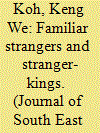|
|
|
Sort Order |
|
|
|
Items / Page
|
|
|
|
|
|
|
| Srl | Item |
| 1 |
ID:
081379


|
|
|
|
|
| Publication |
2008.
|
| Summary/Abstract |
This article examines the controversy surrounding a Chinese Malaysian student's use of the Malaysian anthem in a rap song criticising the corruption of Malaysia and its marginalisation of the ethnic Chinese. Race and religion have been crucial in the imagining of and contestations over the Malaysian nation. They became taboo subjects in the public sphere after the 13 May racial riots in 1969. Language, education, and the mass media became important fields of contestation between the Chinese communities and the Malay-dominant government. With the growing state control of traditional public media such as television, radio, and newspapers, the internet thus became an important space for the stifled public sphere. Concomitantly, dissatisfaction with the dominant party coalition has led increasingly to the growth of a multi-ethnic opposition that encompasses the different ethnic groups. Wee's songs and the political backlash resulting from the government's attempts to suppress it exemplify the convergence of these forces. They also tell us something about the ways in which ethnicity, diaspora, and nationalism intertwine in the imaginings and world-view of a Chinese Malaysian student who felt himself displaced by the national education system. Taiwan, an important cultural and political node in the Chinese overseas imagination, constituted escape, opportunity and an important cultural and political influence but he remains oriented towards his homeland. His songs show how his identity is framed within the local (Muar), the ethnic (vis-a-vis the Malays on the one hand and the other Chinese linguistic communities on the other) and the nation (Malaysia and vis-à-vis Singapore)
|
|
|
|
|
|
|
|
|
|
|
|
|
|
|
|
| 2 |
ID:
155457


|
|
|
| 3 |
ID:
155461


|
|
|
|
|
| Summary/Abstract |
Early modern Malay historiography has been dominated by the history of European trading, colonial empires and local port-polities, often framed along indigenous-versus-foreign lines. Yet, mobility has long been a central feature of this region shaped by commerce, as evidenced by the historical phenomenon of the ‘stranger-king’. This study examines the cultural, political and economic impacts of intra-regional migration and diasporic communities in this region, specifically comparing the interconnected histories of the Chinese, Bugis, Arab, and Minangkabau communities in the seventeenth and eighteenth centuries. Locating this history within that of maritime Asia, this study provides a nuanced understanding of the historical Malay world beyond essentialism and communalism. This article highlights why scholars of the Malay world should take into account the important roles of mobility and ‘strangers’. It concludes that the Malay world was not a timeless or natural construct, but one whose contours and identity were continually shaped by significant diasporic communities and historical encounters.
|
|
|
|
|
|
|
|
|
|
|
|
|
|
|
|
|
|
|
|
|